At a time when many of us — employees and executives alike — work from home, it’s become all too easy to forget about the consequences of poor office morale.
Without sharing space with members of our team, gauging employee engagement and its impact on team productivity can be pretty difficult — but not impossible.
Learning how to boost employee morale should help you create a workplace culture you and your staff can be proud of.
To help you achieve that goal, we’ve spoken to experts who were willing to share their best tips for boosting office morale — even if your company is operating as a hybrid or remote workplace.
So, without further ado, let’s talk about the best ways to boost employee morale.

- Executives and managers should learn how to boost employee morale by attending leadership and empathy training.
- You can use active listening and surveys to keep track of office morale fluctuations.
- Communication is crucial to improving employee morale — from communicating roles and expectations to being able to accept and act on employee feedback.
- The easiest way to boost employee morale is to give employees more than they expect to receive in terms of benefits.
- When creating your benefits package, remember to ask your employees which perks would be useful to them.
Table of Contents
Tip #1: Prioritize employee morale
According to Elisabeth Duncan, VP of Human Resources at Evive, high employee morale is crucial for building a positive company culture.

“Employee morale creates a healthier, happier culture where employees feel supported, encouraged, and experience high levels of job satisfaction.”
As such, organizations that choose to prioritize employee morale over other matters can enjoy many benefits:

“Organizations that prioritize employee morale:
- Deliver personalized, consistent messaging throughout the employee journey,
- Boost engagement [and] performance, and
- Attract high performers.
In the age of the Great Resignation, high employee morale:
- Reduces staff turnover and recruitment costs,
- Lowers medical expenses and absenteeism, and
- Improves brand reputation.”
Furthermore, creating a “strong supportive culture” should make the employee experience “more authentic, meaningful, and inclusive:”

“Engaging and listening to employees demands a level of personalization throughout the employee experience that:
- Builds trust,
- Encourages open communication, and
- Boosts productivity.
Adopt an integrated communications platform to highlight their total rewards package, aid in listening to employees, send and receive personal benefits communication, and tailor the employee experience.”
Ultimately, creating a positive work environment can be as easy as establishing protocols for welcoming new employees and making sure your remote staff feels more connected by knowing how to balance FOTO and FOMO.
💡 PUMBLE PRO TIP
Prioritizing employee morale will ultimately make your company a more pleasant place to work. To learn more about how you can create and maintain a positive work environment, check out this guide:
Tip #2: Provide leadership training and development opportunities
Leadership has a big role to play in ensuring high employee morale, according to Alexis Zahner, an expert on leadership and culture, and the Co-Director of Human Leaders:

“Leaders must understand that they play a role in maintaining employee morale and must be part of the solution when deciding on how to get employee feedback, coach and develop their team, and recognize them accordingly.”
This perspective is shared by Sarah Murdock Ph.D., an organizational anthropologist and the Global Director of People, Leadership, and Impact at Steinberg Hart, who notes that encouraging the development of leadership skills in managers will help the decision-makers within the company become more aware of the employees’ needs:

“For all people managers, I highly recommend starting with leadership coaching, therapy, and/or meditation to prepare one’s mindset. Like parenting, your employees respond to how you’re being and behaving, not what you tell them.”
Of course, extending those development opportunities to non-management employees will also go a long way toward boosting employee morale, as Zahner pointed out:

“Providing ongoing training is also an essential consideration for organizations and will continue to keep employees engaged through learning and skill development.”
The image below shows how an HR employee might use Pumble, the business messaging app, to announce upcoming educational events.
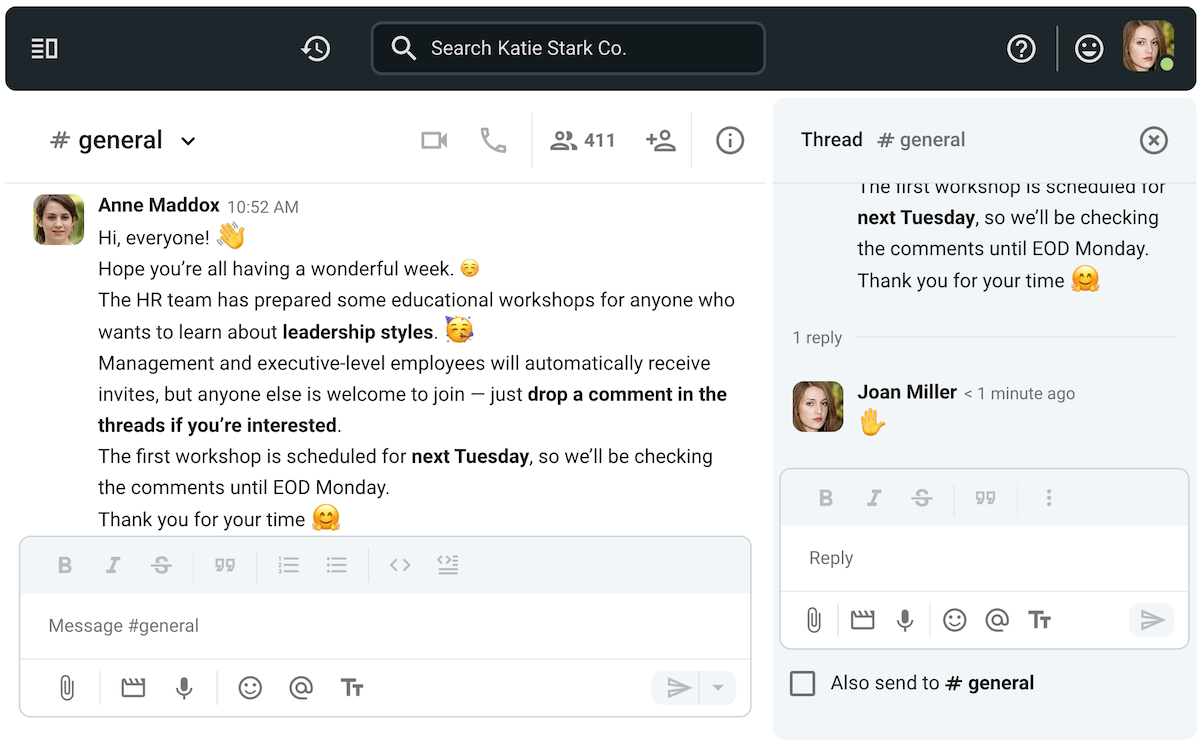
Tip #3: Read the room
The whole point of organizing leadership training is to produce management that can promptly identify and respond to employee needs.
As Holly Schmittle, an HR professional currently working as a Senior People Business Partner at Katapult, told us, it’s all about knowing how to read the room:

“It’s all about reading the room and showing care.
A manager can think they’re doing an amazing job, but if they don’t regularly take the pulse and truly comprehend themes from team feedback, it’s likely that morale will take a serious dip.
Since morale is tied to employee feelings, and it’s intangible, the keys to boosting it are:
- Listening to your team,
- Encouraging and accepting feedback, without being defensive,
- Owning the power you have as a manager to influence morale, and
- Communicating consistently.”
In other words, observing, listening, and judging the overall atmosphere among your people can help when the time comes to show care and interest.
The Founder and Leadership Trainer at Unleash Your Power, James R. Elliot, also states that simply caring about your employees is one of the best ways to boost employee morale:

“Care about employees, and prove it to them – take an interest in their lives, challenges, goals, and support them to get there.”
Of course, good managers can put these tips into practice by regularly engaging in productive downward communication and questioning the management practices they employ, as Elisabeth Duncan recommends:

“Managers and team leads must ask themselves:
- Do employees feel appreciated and rewarded, and do they align with the culture?
- Are you confident that your employees’ well-being, health, and financial wellness are top-of-mind?
- Does your organization listen to their concerns and apply employees’ ideas?”
Tip #4: Use the right tools to measure morale
Unfortunately, introspection alone won’t get you the results you’re looking for.
Instead, you should start tracking employee morale through empirical data.
One way to do that would be through employee pulse surveys, as Matt Erhard, Managing Partner and Executive Recruiter at Summit Search Group, suggests:

“A good place to start is with employee pulse surveys that ‘take the temperature’ of your current work environment. You may find it helpful to make these anonymous, especially if you think some employees may be dissatisfied but fear reprisal if they speak up about the issues they’re having.”
Elisabeth Duncan also noted that regular surveys can be a good way to track employee morale over time:

“Distribute monthly pulse surveys to managers and employees to track employee morale and gain feedback on employee benefit packages and recognition programs and improve internal communications.”
On the other hand, Hilmon Sorey, author, keynote speaker, and Managing Director at ClozeLoop, recommends implementing a human behavior framework like SCALE, which measures:

“S — Status — Ensuring that employees have a sense of importance in their role, a sense of potential, and recognition of success.
C — Certainty — Providing certainty regarding company direction, role expectations, and individual professional development opportunities.
A — Autonomy — Give employees freedom of choice wherever possible. Break down top-down management silos and empower employees with decision-making, options, and flexibility.
L — Likeness — Create opportunities for individuals to feel part of a group or community.
E — Equity — While there is a greater conversation to have about workplace equity, at its foundational level ensure that all employees are treated fairly, have a voice, and feel heard.”
Periodically evaluating employee morale will ensure that your efforts to boost engagement are not in vain.
Tip #5: Get your employees’ input
If you’re looking to boost morale at work, you should know that employees can easily detect a lack of authenticity on their employer’s end.
That’s why Dr. Murdock advises against implementing “generic HR policies,” and recommends keeping your employees’ specific needs in mind:

“Design your team’s experience to support their specific needs — after all, teams are made of actual people with distinct strengths and life circumstances.
Start by asking your people what they need, work with them to try things out, and co-create a phenomenal working environment that makes it easy for them to feel great and do amazing work.
Cultural differences? No problem — be humble, bring in help, or better yet, empower people to design their own working environments.”
A Performance Coach and the Founder of Work with Ashley, Ashley Rudolph, also notes that while “events, parties, and culture building activities are nice” employers should use their resources to answer their employees’ needs with:

- “Student loan support,
- Comprehensive support for parents (IVF coverage, adoption coverage, time off for infant loss, on-site daycare or reimbursement for childcare [depends on the size of the company], etc),
- Corporate sponsored coaching with options for coaches that share their demographics or lane of expertise,
- Free lunch and snacks (this one is still popular), [and]
- Free access to mental healthcare.”
Ultimately, employees should be “involved in the design of solutions,” as award-winning workplace mental health consultant, Allessandria Polizzi, SPHR, Ph.D. told us:

“Too often, executives and HR leaders believe they have to design programs and offerings behind closed doors. Bring employees into the process to spur more creativity and identify what works more quickly.”
Tip #6: Improve communication
If you can’t figure out how to improve employee morale, focus on improving communication, as a Distinguished Professor of Sociology and the Associate Dean at the University of North Dakota, Daphne Pedersen Ph.D., recommends:

“Morale can be improved with:
- Open communication,
- Direct and frequent acknowledgment, and
- By providing employees with opportunities to learn and grow professionally.”
Other experts have acknowledged the role team communication has to play in raising office morale.
However, as Matt Woods, Co-Founder and CEO of Sold.com and a Forbes Real Estate Council Member, told us: “Timing is as important as content.”
Knowing the right time to deliver certain information is a crucial aspect of effective communication, but not the only one you should keep in mind. According to Woods, transparency is another key piece of the puzzle:

“Be strategic in not only what you say, but when you say it. The more transparent you can be, the more your team will trust and follow your lead.”
Teaching Professor and a Faculty Member at the School of Communication and Information, Rutgers University, Richard Dool, also believes that improving employee morale has to start with transparent communication:

“Leaders need to create a positive environment, where employees feel valued and respected. This starts with open, active, and transparent communication.”
But, above all, internal communication should be consistent, as Annie Raygoza, Director of Client Services at Clear Digital, told us:

“It’s also important to ensure consistency around communication is occurring. When people feel heard and understood — they’re more likely to feel like they’re part of something bigger.
They should be acknowledged for wins and areas of improvement. Only then, does the line of trust and morale grow.”
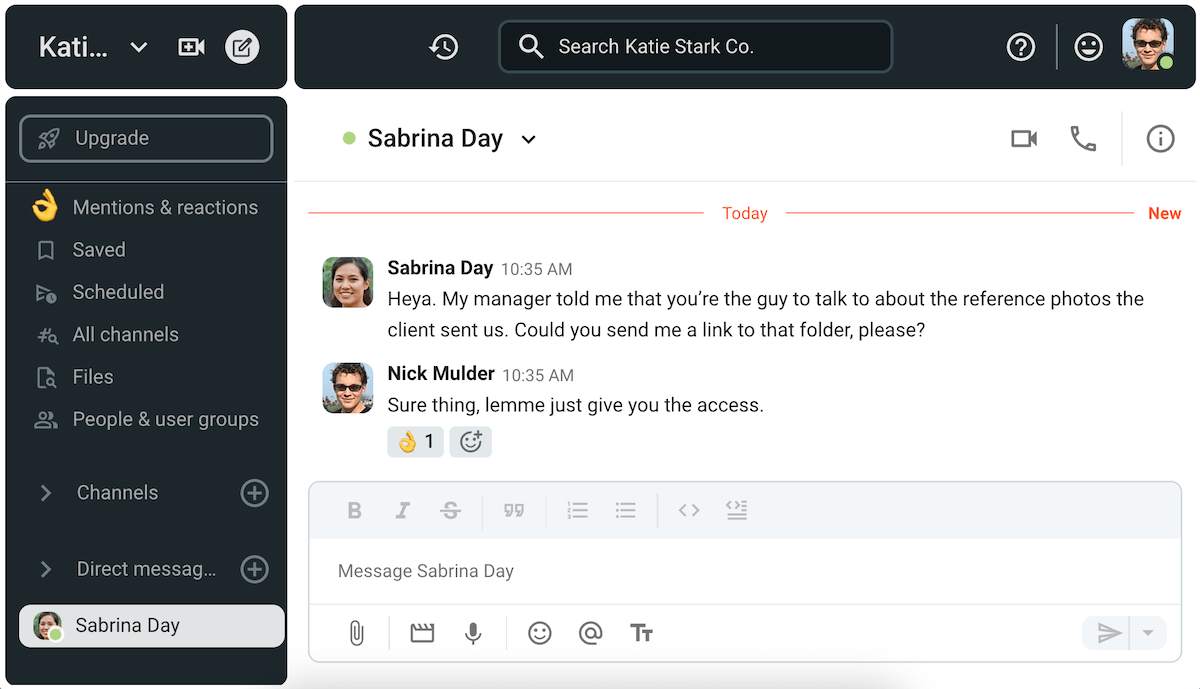
Tip #7: Establish clear roles and communicate expectations
Consistency in communication needs to be established from the very beginning of your relationship with your employees — starting with establishing team roles and responsibilities.
Unfortunately, according to a Gallup estimate we have included in our workplace communication statistics report, only 50% of employees know what their managers expect from them.
That’s what makes communicating expectations so crucial, according to Mary Alice Pizana, an HR Manager at Herrman and Herrman PLLC:

“High-quality managers clearly communicate their expectations for each team member and provide quality feedback for their team.
These interactions help improve the work environment by making it clear to team members their role and how they contribute to the organization’s overall goals.”
Similarly, Zahner finds that discovering why some employees underperform could boost employee morale in the long run. She advises leaders to focus on bridging this gap between where the employees are and where managers need them to be:

“Identifying the gap and coaching it can help boost employee morale when the issues are associated with skills-based or self-efficacy issues. Low employee morale can be a result of the employee underperforming in their role.
Taking time to understand if and where employees are struggling in their roles and helping them to bridge the gap from where they are to where we need them to be will help build their own self-belief that they’re capable (self-efficacy), boosting their motivation and satisfaction and show that we care and value their contributions.”
Tip #8: Celebrate even the smallest achievements
Once everyone knows what they’re supposed to be doing, you’ll want to start highlighting their achievements — no matter how small.
After all, recognizing employee achievements will make everyone feel like their work is important to the company, according to Pizana:

“Managers taking the time to recognize and celebrate their team’s achievements helps show the team that their bosses are invested in their work and appreciate their effort.”
Being able to recognize your team’s achievements and provide praise proudly and publicly will make all the hard work your employees have put in seem worth the effort.
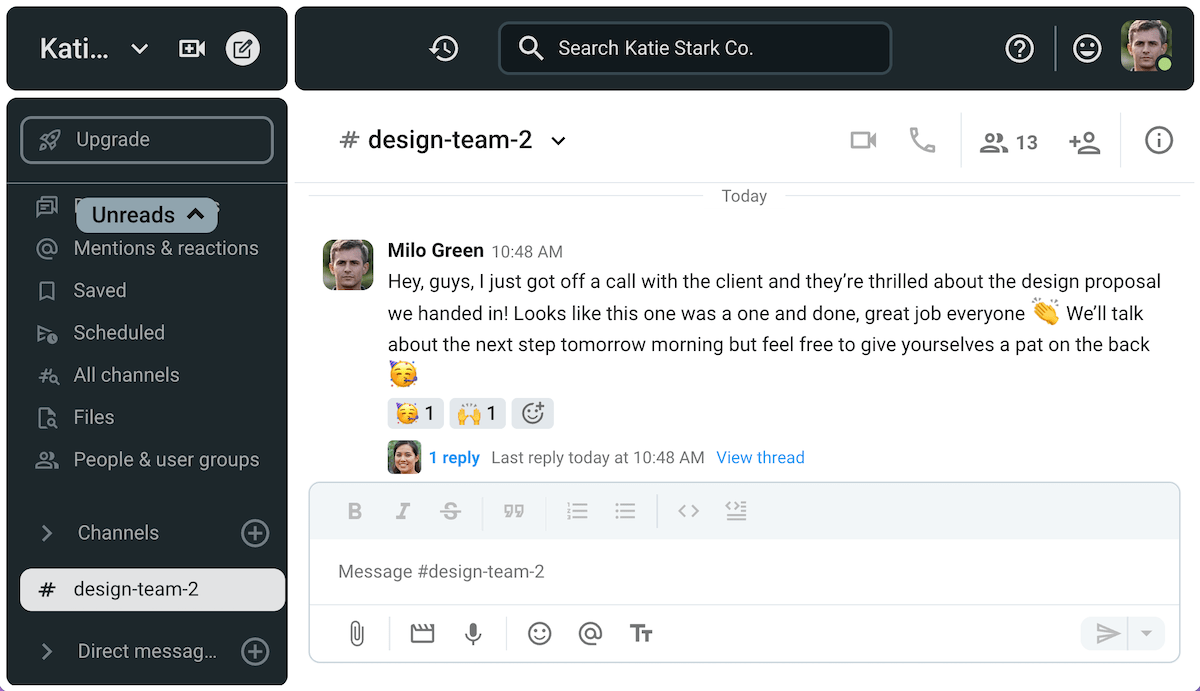
Tip #9: Recognize individual contributions
While celebrating team achievements is important, highlighting individual contributions is also crucial.
After all, according to Dr. Pedersen, practicing respectful communication and showing your people that you genuinely value what they bring to the organization is one of the easiest ways to boost office morale:

“Employee morale increases when people feel they are respected and acknowledged for the important contributions they make to the organization – and they are empowered to do their work.”
One way to recognize individual contributions would be to introduce cash incentives, as Anjela Mangrum, Founder and President of Mangrum Career Solutions and a Certified Personnel Consultant, suggested:

“If you need your workers to do their jobs well and on time, it’s worthwhile to make efforts to heighten overall team morale. In my opinion, employee recognition is a key factor in boosting morale. Making your hard workers feel valued with verbal praise or cash incentives provides a great performance boost.”
But, if you’re not sure your employees would be interested in that kind of rewards system, you can always ask your employees what kind of recognition they’d prefer to receive, as Zahner advises:

“Ask your employees how they want to be rewarded and what they value. This might be flexible working arrangements, rostered days off, contributing to local charities or volunteer work, or perhaps monthly and quarterly team recognition days.
Many organizations fall into the trap of thinking cash is king when it comes to employee recognition and often miss the mark with what motivates employees and makes them feel good about their work.”
Tip #10: Find the right approach to address error making
Even if you train your management to become effective communicators and set clear expectations, chances are, there will still be people who underperform.
But, being too aggressive with those underperformers — or, conversely, not addressing those mistakes at all — can negatively impact team morale.
One way to alleviate those concerns would be to have managers take responsibility for their team members’ work, as James R. Elliot suggests:

“Take responsibility for people’s results (this does not mean you actually have to DO the work) and find ways to help them to get there/ask them what they need/help them figure out what they need.”
If mistakes still happen, a good manager should try not to keep score, as that, too, can have an undesirable effect on employee morale, as Lattice Hudson, Business Coach, Leadership Mentor, and Owner at Lattice and Co., noted:

“Workers want to feel that their hard work is appreciated, and many prefer to be compensated for it when feasible. Managers who consistently point out employees’ faults, on the other hand, create a breeding ground for employee unhappiness.”
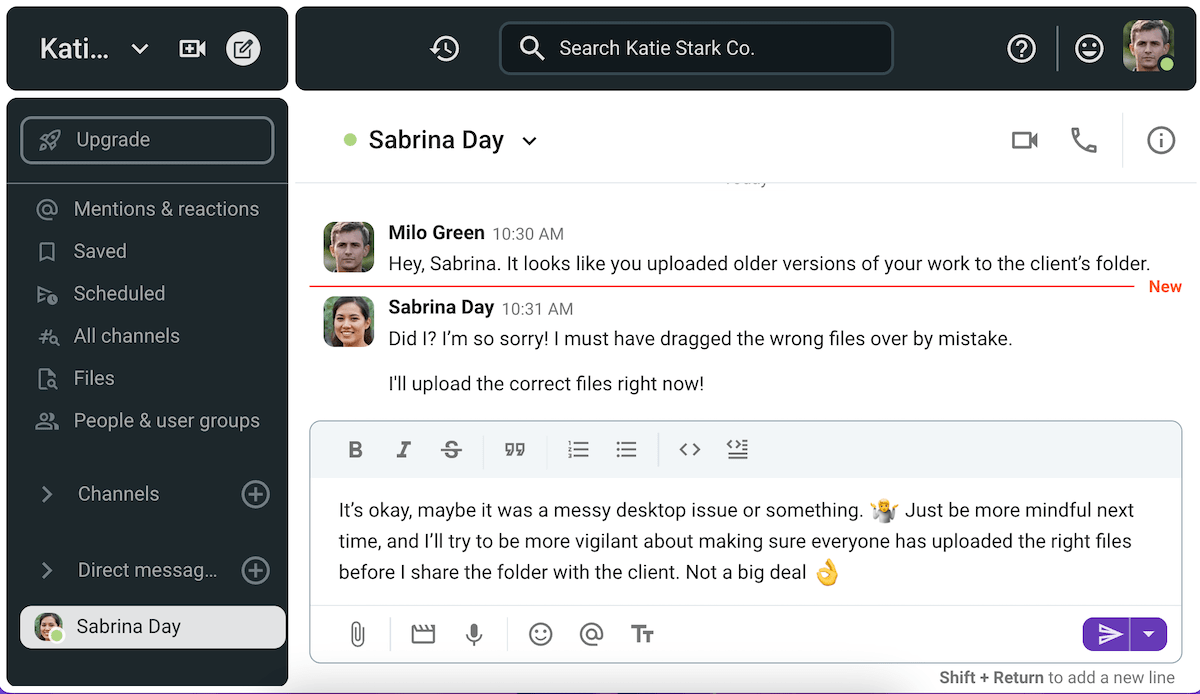
Tip #11: Provide flexibility and agency
With the spread of distributed teams and remote-first work models, we’ve seen how allowing employees to choose when and where they work can improve office morale.
In the words of Matt Erhard, it’s all about giving employees more agency:

“There are some things that are often successful in improving morale. One of them is giving employees more agency and flexibility to work when and where is best for them.”
For more specific advice, we turned to Teshia Davis, VP of People and Culture at SECU Maryland, who explained how she improved the experience of remote employees at her company:

“Keeping employees engaged in a hybrid work environment involves meeting them where they are and prioritizing their needs, which then become prerequisites — and the foundation of an overall wellness strategy.“
She explained how we can change our mindset so it benefits employee morale:

- “Be purposeful in connecting with colleagues.
- Offer grace in acknowledging that we all work differently, especially when doing so remotely.
- Always offer flexibility to your teams, particularly because everyone’s personal and professional lives are now intertwined.
- Support and promote mind, body, and financial wellness with your employees.”
But, with that being said, it’s important to acknowledge that flexibility can be offered even to on-site employees by offering:
- Multiple work locations,
- Flexible start and end times, and
- Varying shift lengths.
💡 PUMBLE PRO TIP
If you are in the process of making a remote-first company, these articles will help you manage your people:
Tip #12: Give employees more than they expect
Employee morale can’t be enhanced by providing everyone with the same perks and benefits, such as free gym memberships or birthday gift cards — it only makes you look lazy and indifferent.
If you want to exceed your employees’ expectations, try:
- Adding more days to everyone’s PTO balance unexpectedly,
- Giving your employees a bigger raise than they asked for,
- Hosting a “Bring Your Family to Work Day” or similar activity, or
- Arranging for each employee to get a day off on their birthday.
Dr. Murdock believes companies can stand out by upgrading their perks and benefits programs:

“Morale is tied to compensation and title to some degree, but significantly more to meaning, appreciation, and true teamwork.“
She highlights that even financial compensation will only get you so far:

“Smart companies understand that generic perks like parties or swag won’t help much with morale. Instead, smart companies invest in benefits, bonuses, and professional development.
But companies that are really leading understand that even money and benefits only go so far. After all, if compensation were the key to employee morale we’d only see high success rates in finance, tech, and other highly lucrative industries.”
If you make an effort to keep your employees’ desires and expectations in mind when creating your benefits package, you’ll find them much more inclined to do their best for the organization.
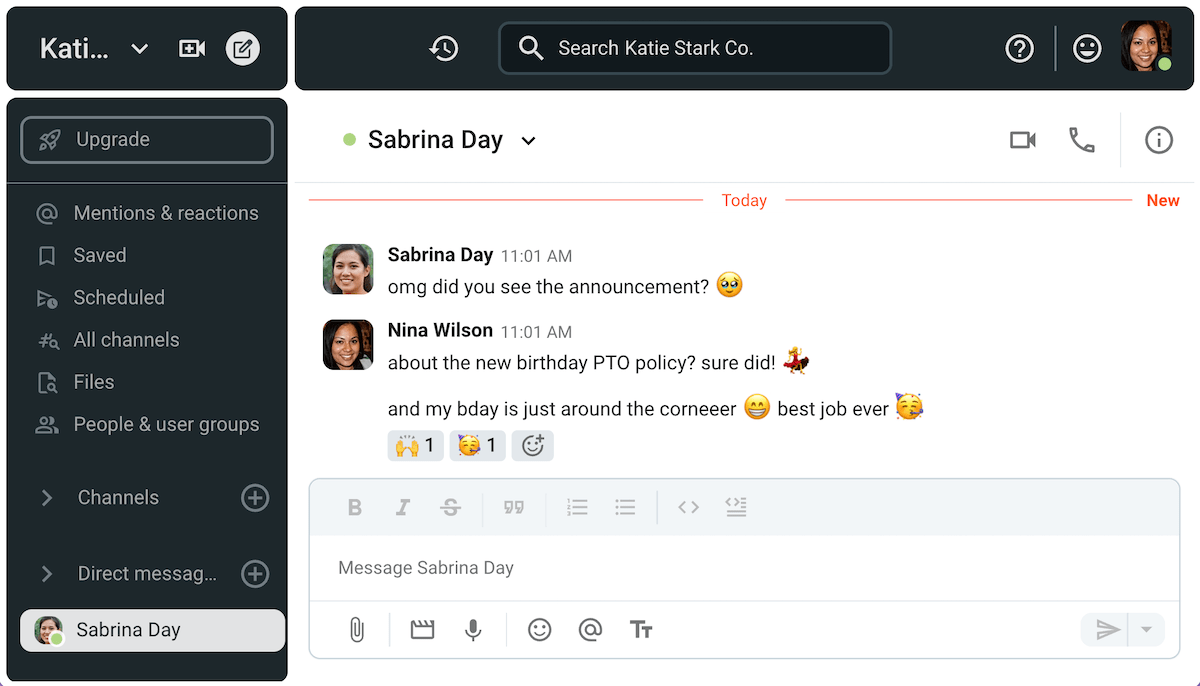
Tip #13: Provide, encourage, and act on feedback
Despite managers’ and team leads’ reluctance to give feedback, 72% of employees believe that constructive feedback could improve their performance, according to the Pumble workplace communication statistics we have compiled.
Normalizing feedback will allow your employees to stop seeing feedback sessions as something to be afraid of and consider how feedback and feedforward can positively affect the future of the company.
Having said that, there are 3 things you can do to normalize feedback in the workplace:
- Encourage employees to ask for feedback,
- Take responsibility for the employees’ feedback, rather than getting defensive, and, most importantly,
- Act on the employees’ feedback.
Keynote speaker, Concierge Coach, and President of EleVive, Elizabeth Lombardo, Ph.D., explains how managers can encourage employees to actively and independently ask for feedback:

“Employers and supervisors can give employees the skills to ask for feedback to boost employee morale. Managers have led the feedback process to assist staff in course correction and growth.
However, the greatest method to improve the free flow of feedback is to encourage people to seek it out independently.”
On the other side of the conversation, managers should also be prepared to take responsibility for the feedback they get from employees, as Zahner told us:

“It’s important for all leaders to understand that feedback from employees may feel uncomfortable, but accepting radical responsibility for addressing employee morale happens at all levels — as leaders, we’re part of both the problem and the solution, so we need to take accountability for this.”
On top of that, Mangrum noted that leadership should be able to promptly act on the feedback they have collected:

“Welcoming your team’s feedback and acting upon it is another significant morale booster, the exact opposite of a demoralizing attitude where employers suppress their staff’s voices and act as sole decision-makers.”
Tip #14: Organize regular 1-on-1 meetings
One way to normalize feedback within your organization would be to encourage managers to have regular 1-on-1 meetings with their team members.
As Job Search Strategist, Career Coach, and Founder of SoulWork, Stephanie Heath, told us, 1-on-1 conversations are great tools for employee development:

“People managers should set aside blocks of time (one hour per week per employee) for not only reviewing the output of the team and its individual members but to nurturing each team member by:
- Brainstorming opportunities to connect with them based on their interests,
- Reviewing onboarding personality assessments provided by DISC or another organization,
- Dedicating time to think about what may be happening in that employee’s personal life (based on what was shared by the employee) and go out of their way to follow up,
- Dedicating time to review/remind themselves of the ideal career trajectory of each team member and ask themselves if their current project is in line with this person’s long-term goals, and
- Preemptively suggesting and getting approval for continuing education, technical development, or leadership opportunities per member unrelated to their work output. Not needing to earn these opportunities but have them provided because they are a valued member of the team.”
Heath also noted that conducting effective meetings and acting on employees’ input requires empathetic leadership:

“People managers need to enroll in an empathy course to develop empathy skills so that caring about each member becomes more natural than what was the norm in previous years.”
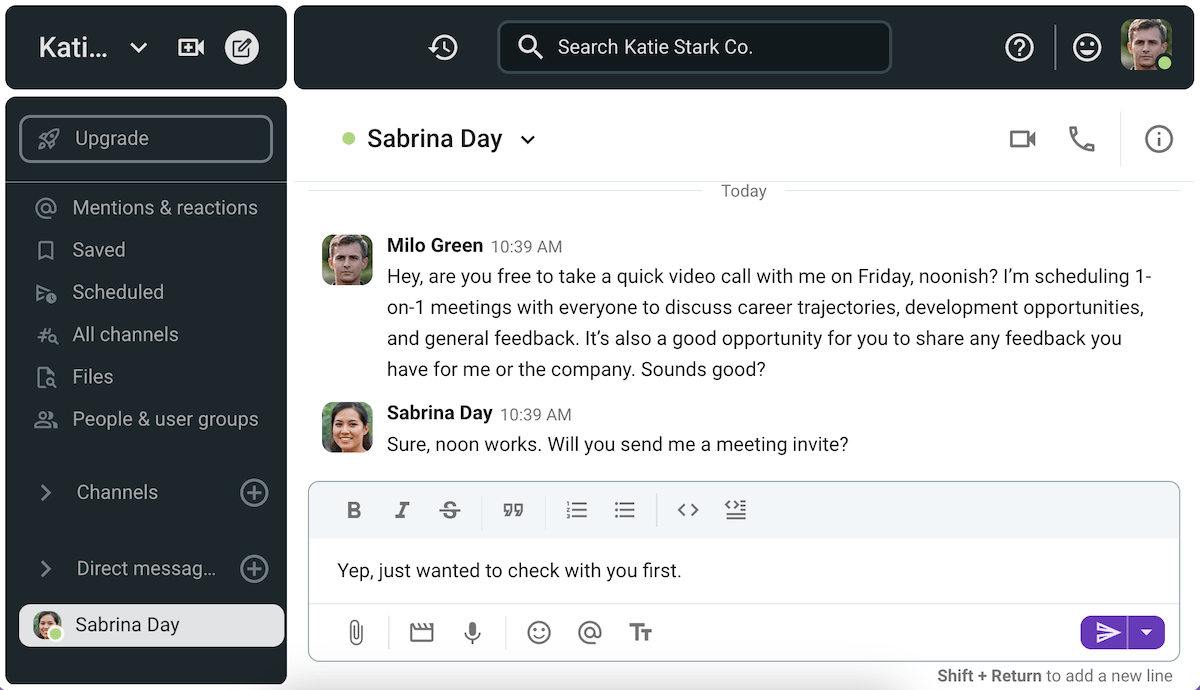
Tip #15: Make sure all employees are given a voice
As you can imagine, the previous 2 tips we have shared both boil down to the same thing — allowing employees to have a voice.
According to Alexis Zahner, letting your people voice their desires, concerns, and requests should enable you to determine the cause of low morale:

“Understanding the cause of low morale is an important place for leaders and organizations to start when trying to boost morale. It’s seemingly simple, but connecting with employees and providing them the opportunity to voice their challenges and concerns will help uncover the root causes of low morale.
Think about it. No one likes to feel unseen and unheard. If there’s no mechanism in your organization for employees to contribute their opinions in this way, this is where you need to start.”
If there’s anything we’ve learned from the Great Resignation, it’s that taking this kind of employee-first approach can be a good way to keep your best people engaged and motivated.
So, how can you encourage employees to voice their concerns?
Well, one thing you could do is implement an open-door policy in your organization — but make sure you’re willing to follow through!
As an executive, you can also make sure that your subordinates are being heard by organizing skip-level meetings.
💡 PUMBLE PRO TIP
Knowing how to engage in respectful and productive two-way communication will make work much easier and more enjoyable for everyone. To learn more about how to engage in and encourage productive conversations in the workplace, check out this article:
Tip #16: Be mindful of cultural and generational differences
People like to think that corporate environments are free from human weaknesses like cognitive biases — but that couldn’t be further from the truth.
Leadership and employees alike can both exhibit in-group biases that stop them from collaborating with coworkers who don’t belong to the same social groups as they do.
As you can imagine, that can seriously impair employee morale — which is why we have to fight against that kind of prejudice, according to Erhard:

“Fixing these problems is a very effective way to increase morale across your organization, especially among employees who belong to marginalized communities.”
In fact, being intentional about including and centering diverse talent will ultimately result in a more positive workplace culture, as Elisabeth Duncan remarked:

“Organizations need to:
- Create new opportunities for diverse talent,
- Change business processes,
- Help employees form respectful social connections, and
- Create a culture where differences and similarities are appreciated and embraced.”
Duncan also noted that forming a culture committee could be a good way to ensure that every employee’s experience with the company is a fulfilling one:

“Form a culture committee that is more than a cross-functional and multilevel team but representative of employees with different personalities, education, interests, hobbies, race, and sexual orientation.
The committee’s goal is to plan programs, actions, and events that support the company’s mission, purpose, and values and help employees discover common interests and values and views.”
💡 PUMBLE PRO TIP
If you want to make sure your employees are letting go of their in-group biases, try encouraging cross-cultural and cross-generational communication:
Tip #17: Practice active listening
Of course, making sure that employees have a voice will count for nothing if managers and executives don’t know how to listen, Dr. Dool noted:

“The employee wants to know their voice matters, so leaders need to be good listeners and actively seek employee input.”
According to Dr. Mike Merril, leadership expert and co-author of the book Leadership is Overcoming the Natural, a crucial aspect of building team morale is active listening:

“Morale can be improved by active listening. To be genuinely heard can be a transformative experience. When someone directs their full attention to you, your words, and even the unsaid meanings behind them, it’s incredibly powerful. This sense of validation boosts team morale and improves overall organizational performance.”
Besides, as the co-founder of Kudoboard, Aaron Rubens, told us:

“Each employee is unique in what they have to offer and what they hope to gain while employed. Listening to what employees have to say can help steer things in the right direction.”
In other words, being open to what your employees have to say will allow you to be more proactive about keeping office morale levels high.
All this should make your company one that most employees are reluctant to leave, as Elisabeth Duncan pointed out:

“Employers that listen and use the input to develop a culture aligned with people’s values and beliefs create a future-ready organization where employees feel cared for and supported and don’t want to leave.”
Ultimately, active listening is about reading between the lines and interpreting what employees aren’t saying or what they might be unwilling to share.
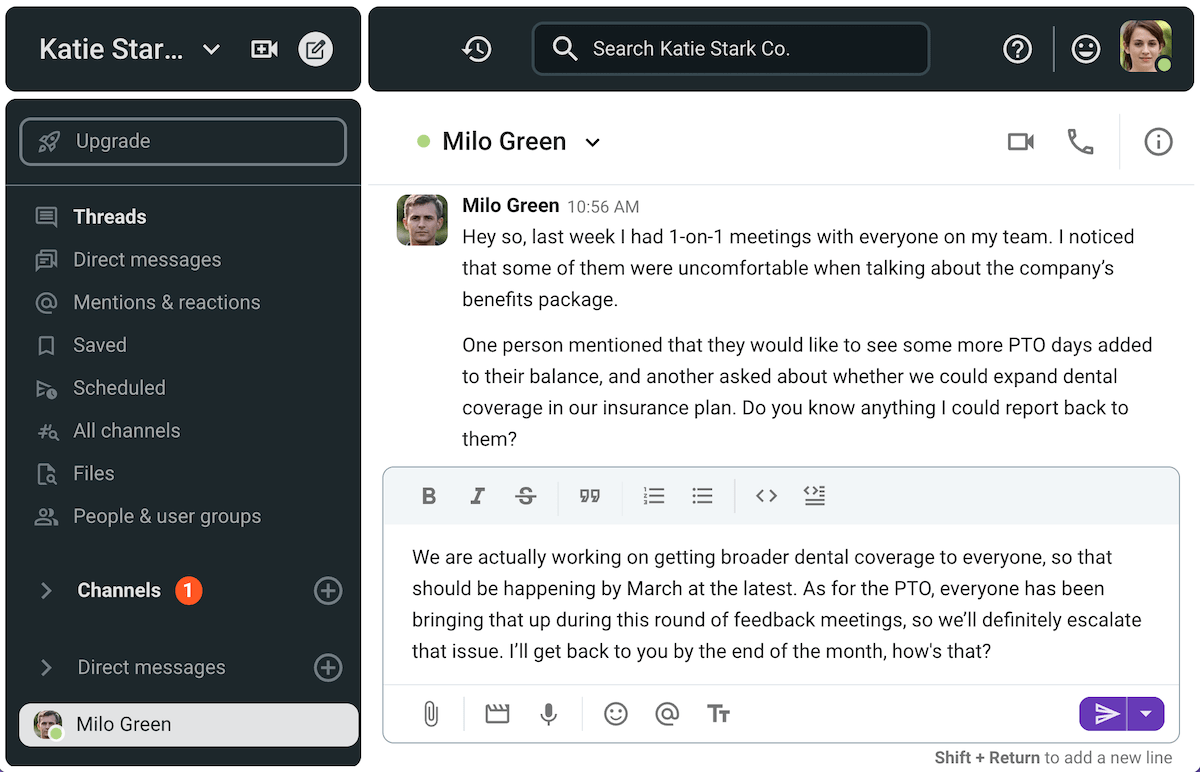
Tip #18: Lighten the employees’ mental load
In the past several years, we’ve all realized the effect employee mental health and well-being can have on office morale.
Minimizing the stigma around these issues and addressing them head-on could be the solution to the low morale we’ve been seeing, according to Elisabeth Duncan:

“Mental health, financial challenges, and wellness challenges have impacted the workplace.
Yet, people with health or financial difficulties often don’t get the help they need because of the stigma and discrimination they face. Dedicate the time and resources to expand employee mental health, financial education, and well-being benefits.”
Allessandria Polizzi also highlighted this problem, stating that companies should start by identifying potential psychological hazards:

“One highly overlooked approach to employee engagement is to identify what potential psychological hazards exist that prevent people from feeling safe enough to engage. We know from decades of research that workload, lack of clarity, and misaligned values can undermine even the most enthusiastic and dedicated employee. Leaders should look at the identified hazards available through the WHO or ISO 45003 to assess what might be in the way.”
Identifying and eliminating these psychological hazards will grant your employees a sense of psychological safety in the workplace, allowing them to see the company and its leadership in a more positive light.
After all, according to Dr. Dool, this is how leaders can do their part to increase office morale:

“Leaders must create an environment that offers value, drives learning, promotes cohesion, and is positively framed. This will increase morale, which leads to higher job satisfaction, productivity, engagement, and retention.“
💡 PUMBLE PRO TIP
Making sure your employees’ wellness needs are taken care of may start with respecting their work-life boundaries. To learn more, check out these articles:
Tip #19: Strengthen personal relationships
To learn how to boost employee morale, you should understand that community-building will be a big part of that.
Having recently gone through a period of social distancing and isolation, we are now, more than ever, in need of meaningful relationships.
And, since we already spend a good chunk of our days at work, we might as well start by strengthening the personal relationships we have with the people we work with.
For Mikaela Kiner, Founder and CEO of Reverb, an HR consulting company, strengthening personal relationships is all about opening up to others:

”Leaders have the power to set the tone for their teams and can focus on a few key things to boost or maintain high morale.
Build personal relationships. Know people’s partners’ and pets’ names. Treat people like people, not like cogs in a wheel.
Open up, share, and be vulnerable. When you admit mistakes and challenges, people know they don’t have to be perfect.”
On that note, Aaron Rubens recommends making time to discuss things that happen outside of work with your team:

“It is important to remember that employees are not machines, they are people. They have needs, personal lives, families, hobbies, etc. Making time for discussing life outside of work is an excellent way to stay connected as a team.”
Leadership can also make an effort to encourage employees to build stronger bonds amongst themselves by suggesting team-building games and bonding activities.
As Anjela Mangrum notes, we can’t expect employees to maintain their morale and motivation if they don’t get a chance to relax and unwind from time to time:

“Providing opportunities for employees to have fun and bond leads to the development of a positive work environment where they get along and facilitate each other’s jobs.”
Tip #20: Trust your people
If you’re looking to boost morale at work, you’ll need to start trusting your employees.
That’s how you’ll get them to trust you when you communicate with them — and give you their honest feedback and commitment in return.
A lack of trust, on the other hand, can make an office a breeding ground for unconscious biases and micromanagement — which are “some of the biggest morale killers within the workplace,” in Matt Erhard’s opinion.
Besides, employees want to be trusted, according to Dr. Dool:

“Employees want to be trusted. Leaders need to establish goals, boundaries, and rules of engagement and then get out of the way and let the employees get it done.”
Luckily, there is an easy way to build trust.
In Annie Raygoza’s view, it comes down to paying attention to your people and being on their side:

“Make the time to have consistent check-ins with employees. Document the conversations, and follow through with all tough questions and longer-term goals. Having this level of attention and motivation will boost morale and also help employees feel like they have someone in their corner.
Trust is a big factor in a relationship and can be established only through these strategic touchpoints. These are also special moments to highlight things they’re doing well, note how they’re progressing in this career path, and encourage them to improve areas of weakness.”
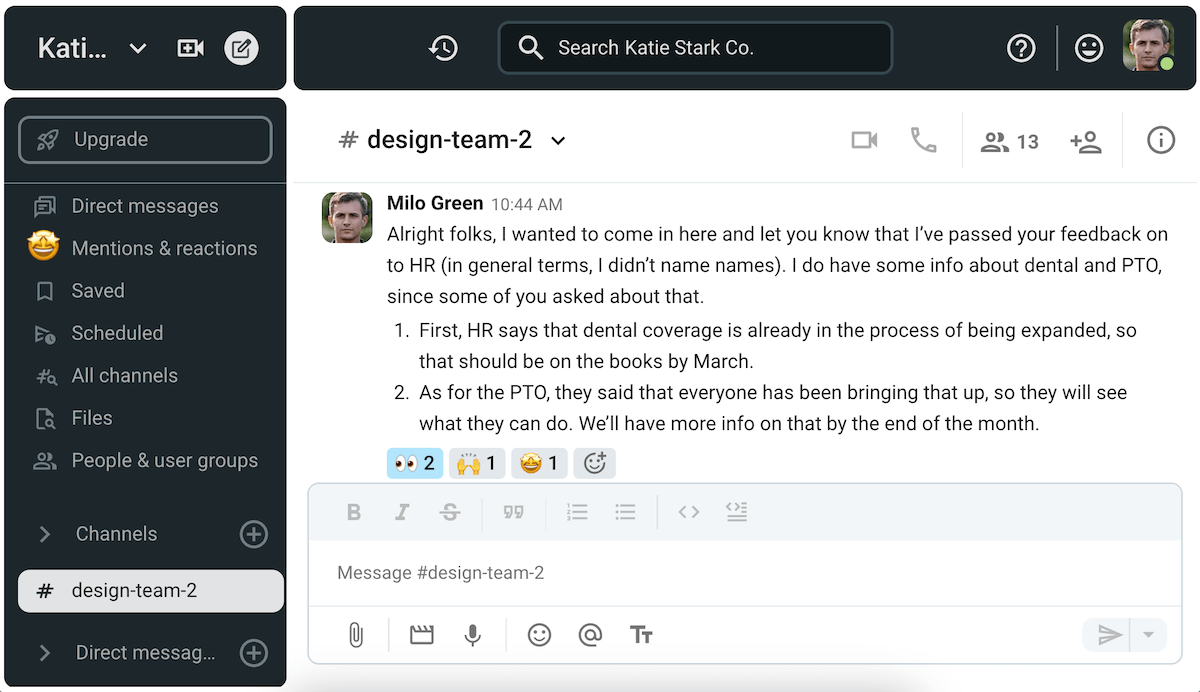
How to boost employee morale with Pumble
Ultimately, learning how to boost employee morale is all about being willing to work with your employees on creating the kind of work environment they can thrive in.
The only way to do that is to ensure open and honest communication that allows everyone to have a voice — but that can’t be done over email.
According to Elisabeth Duncan, most employees think of email as an old-fashioned and inefficient tool of communication, anyway:

“Mass emails are often seen as employer spam. As a result, this kills morale, wastes people’s time, and leads to disinterest.”
What she proposes instead of email is to “distribute personalized messages to the right employee at the right times based on their preferred communication, showing employees their time and opinion matters.”
One way to achieve that kind of personalized communication is with Pumble, the employee communication app:
- Send direct messages to let employees know their work matters.
- Use message reminders to make sure you’re not dropping any conversations.
- Have 1-on-1 feedback sessions through Pumble’s video conferencing feature.
- Let your employees decompress by setting up different channels for them to have casual conversations. You can have one channel for random water cooler topics, one for movies and shows, one for pets — the possibilities are endless!
Don’t forget to check out the other Pumble features that make workplace communication a breeze.




